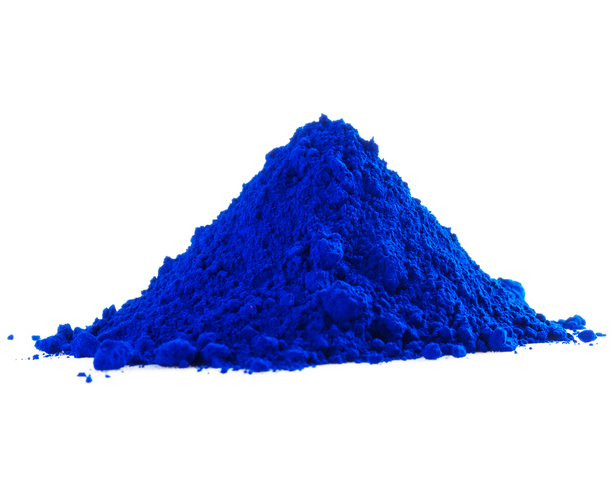

By Robert J. Verdicchio
President/Founder, Verdi Enterprises, Inc.
October 15, 2017
A new addition to the personal care arena is currently being reviewed for its anti-aging properties. During the 1950s, while doing organic process development at Lever Brothers, I recall using methylene blue to monitor the conversion of reactants to anionic surfactants. This article sheds light on some of its other uses, both in medicine and particularly the use potential in cosmetics.

Figure 1: Physical appearance of methylene blue.
A Photosensitizer for Diagnosis and Treatments in Medicine
Photosensitizers are extensively used in medicine particularly to mark or differentiate the boundaries of malignant cells from normal cells. A photosensitizer absorbs light, which results in a photochemical change within the molecule. When light strikes a solid object, it can either be scattered or absorbed: the first law of photochemistry (Grotthuss–Draper law) states that absorbance (compared to scattering of light) is a necessary prerequisite for photochemical changes to occur. Compounds that exhibit absorbance are called chromophores. The absorbed light leads to an energy exchange in which the molecule can release heat and/or fluorescence. Some compounds emit the absorbed energy as fluorescence.
Methylene blue is a phenothiazine dye and is the only molecule in this class to be extensively evaluated for clinical applications. To this effect, methylene blue is used as a tumor marker during surgery and also as a vital diagnostic marker in pre-surgery. Concurrently, methylene blue is being investigated for pathogen reduction in blood products. As of now, the Swiss have jumped out in front, as the pioneering Swiss Red Cross currently uses methylene blue to lower bacterial contamination of blood and for eradication of plaque. Continued research has led to derivatives of methylene blue, which have been tested as possible treatments for chronic skin tumors.1 Since first being synthesized over a century ago, a myriad of clinical applications have been developed for methylene blue, leading to treatments for diseases including methemoglobinemia, malaria, vasoplegia, septic shock, cancer chemotherapy, and Alzheimer’s disease.
Antioxidants for Cellular Senescence
Aging cells cannot overcome the assault of free radicals due to a decrease in the skin's normal arsenal of antioxidants. This depletion of antioxidants likely varies on an individual basis, and as a result, the word aging becomes very general, and the need for antioxidants may not even be a function of chronological aging, particularly since an awareness of pollutants and their effects on skin is now fairly well documented. To this effect, antioxidants are essential at all ages to maintain healthy skin: researchers in cosmetic science together with dermatologists are starting to grasp the myriad of free radical-induced skin disorders. A good example consists of recent clinical studies, which demonstrated the beneficial effects of vitamin E for treatment of acne vulgaris.2 Methylene blue is a unique antioxidant that targets reactive oxygen species (ROS) and induces permanent changes in cellular aging according to studies conducted at the University of Maryland.3 One of the unique features consistent with methylene blue is the ability to make permanent changes within the cell via its persistence in keeping ROS at low levels in all three of the major skin layers. As a result, cell senescence was reversed via these studies. Fibroblasts showed a significant increase in cell division leading to increased skin thickness in elderly subjects accompanied by an increase in hydration to levels normally found in younger skin. Additional studies on older subjects showed a reduction in both beta-galactosidase and the P16 gene, both of which are indicators of cell senescence and aging. These results were extended and substantiated using simulated skin in vitro and in vivo on both young and old subjects (80+), which verified both increased skin thickness and significantly higher water retention resulting in more youthful skin.

Figure 2: Molecular structure of methylene blue.
Potential Application of Methylene Blue to Protect the Mitochondrion
The penetration and cellular uptake of methylene blue makes this compound special. The antioxidant properties of methylene blue have been known since its discovery in 1876; however, with increased awareness by scientists regarding the role of uncontrolled ROS and their effects on skin health and disease, more attention has been given to antioxidants in recent years for prevention and cure.3 The mitochondrion, or furnace room of the cell, provides energy via conversion of carbohydrates into adenosine triphosphate (ATP), which cycles and recycles the converted energy to cells by means of the electron transport chain. Inherent to this conversion process, ROS are formed via cellular metabolic waste, which in general are difficult to control, much less, when they are concentrated in the mitochondrion. As a result, it is safe to say that regulation of ROS within the mitochondria is best achieved via the electron transport chain containing an antioxidant, which can move freely in and out of the mitochondrial membranes. We have been searching for a molecule capable of gaining access to the mitochondrial membrane zone to keep ROS at low levels.
How is Methylene Blue Able to Penetrate Mitochondria and Modulate ROS in the Electron Transport Chain?
Penetration into intercellular compartments of the mitochondrion and lipid membranes reflects methylene blue's amphipathic properties (it is both oil and water soluble). It is compatible with a myriad of solvents and has a low redox potential of 11mV. Most antioxidants, particularly vitamins, are either predominantly oil or water soluble. In contrast, the amphipathic nature of methylene blue allows it to move in and out of mitochondria thereby affording it the ability to regulate/mitigate the accumulation of ROS in mitochondrial membranes, which left unchecked leads to both senescence and premature aging of skin. These amphipathic properties of methylene blue together with its low redox potential, translates into a self-generating antioxidant that can exist both in its oxidized and reduced forms simultaneously. The ability to accept electrons in the oxidized state or reject elections in the reduced state allows it to enter the electron transport chain and mitigate free radical buildup, which directly affects cellular functions and in turn can alter/reverse the aging process. Studies have successfully demonstrated this property at relatively low methylene blue concentrations (0.5 to 2.5 µM).4 At this low concentration, there is no blue staining of cells, however repeated use could lead to cumulative effects on skin which should be addressed in pre-clinical/clinical studies.5
Translatable Anti-aging Benefits
Aging skin becomes thin, dry, and wrinkled (skin thickness is depleted in all three layers) and has reduced water retention. Tissue staining studies have shown that treatment of skin with methylene blue (0.5 µM) results in increased thickness of the dermis as well as elevated skin hydration.4 It should be noted that this study was carried out using a commercially available reconstituted full thickness skin model, which is not optimal for aging skin. Product claims like elevated skin hydration, using this type of skin model, requires proper controls, as the substrate is already hydrated prior to use. However, increased dermal thickness and raised lipid levels in the skin, as a result of ROS mitigation via methylene blue treatment, likely provides an effect which enhances the hydration properties of skin.
Nevertheless, the ability to enhance the hydration properties of aged skin has consumer perceivable benefits of smoothness, healthy glow, and, in many cases, fine wrinkle reduction. Aging skin also becomes thinner with time as a result of collagen and elastin depletion. This is likely due to decreased enzymatic production within the extracellular matrix together with increased ROS in the dermis, which results in a degenerative cycle inducing the aging process. After the age of forty, production of both elastin and collagen fall off rapidly while the ROS accumulate, adding to the degenerative cycle. Increased levels of ROS is perhaps the leading cause of both skin aging and disorders, such as acne vulgaris, as the buildup directly results in both breakdown and production of collagen and elastin. Elastin is an extremely important dermal protein responsible for skin pliability, resilience, and elasticity, which promotes firmness and definition of the skin. The deleterious effects of low levels of elastin and collagen translate into sagging turkey skin replete with wrinkles. Such effects may be avoided using the intrinsic antioxidant properties of an antioxidant, such as methylene blue. To this effect, researchers conducting skin tissue work demonstrated an increase in elastin fibers within the dermis after two weeks treatment with methylene blue, which was accompanied with perceived anti-aging effects.5 The foregoing properties of methylene blue as described herein, present a versatile and potentially unique addition to the existing antioxidant arsenal, together with the water and oil soluble vitamins and polyphenols designed for personal care products.
References
1. http://photobiology.info/Berg.html
2. O.H. Mills, M.C. Criscito, T.E. Schlesinger, R. Verdicchio, and E. Szoke, Addressing free radical oxidation in acne vulgaris, J. Clin. Aesthet. Dermatol., 9, 25-30 (2016).
3.
B. Schleehauf, Methylene blue—the antioxidant answer to aging? Cosmet. & Toil., June 7, 2017.
4. Z.-M. Xiong, M. O’Donovan, L. Sun, J.Y. Choi, M. Ren, and K. Cao, Anti-aging potentials of methylene blue for human skin longevity, Sci. Rep., 7, Article number: 2475 (2017).
5.
P.R. Ginimuge and S.D. Jyothi, Methylene blue: revisited, J. Anaesthesiol. Clin. Pharmacol., 26, 517-520 (2010).